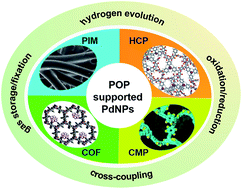Porous organic polymer material supported palladium nanoparticles
Abstract
As a rapidly emerging class of polymers with a high specific surface area, customizable structures, tunable pore sizes, and readily available building blocks, porous organic polymer materials (POPs), particularly highly ordered crystalline covalent organic frameworks (COFs), have garnered considerable attention from both academic and industrial communities due to their broad range of potential applications in storage, separation, and catalysis. They also represent excellent candidates for supporting and stabilizing metal nanoparticles (NPs) for heterogeneous catalysis. As one of the most widely used metal catalysts, palladium (Pd) catalysts, particularly PdNPs with a large accessible surface area, have been playing a critical role in energy and environmental applications, such as catalyzing chemical transformations, gas storage/fixation, etc., and their development has thus received great attention of the scientific community. In this review, the state-of-the-art strategies for the directed growth and immobilization of PdNPs using various POPs as the support (PdNPs@POPs) are discussed. PdNP size effects and their synergistic interactions with POP supports for important applications such as oxidations/reductions, coupling reactions, hydrogen generation and gas storage/fixation are discussed as well. The pros and cons of a PdNPs@POP system are summarized, and the current challenges as well as possible future research directions are discussed at the end.



 Please wait while we load your content...
Please wait while we load your content...